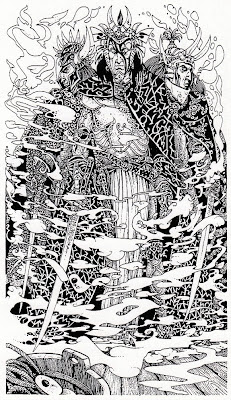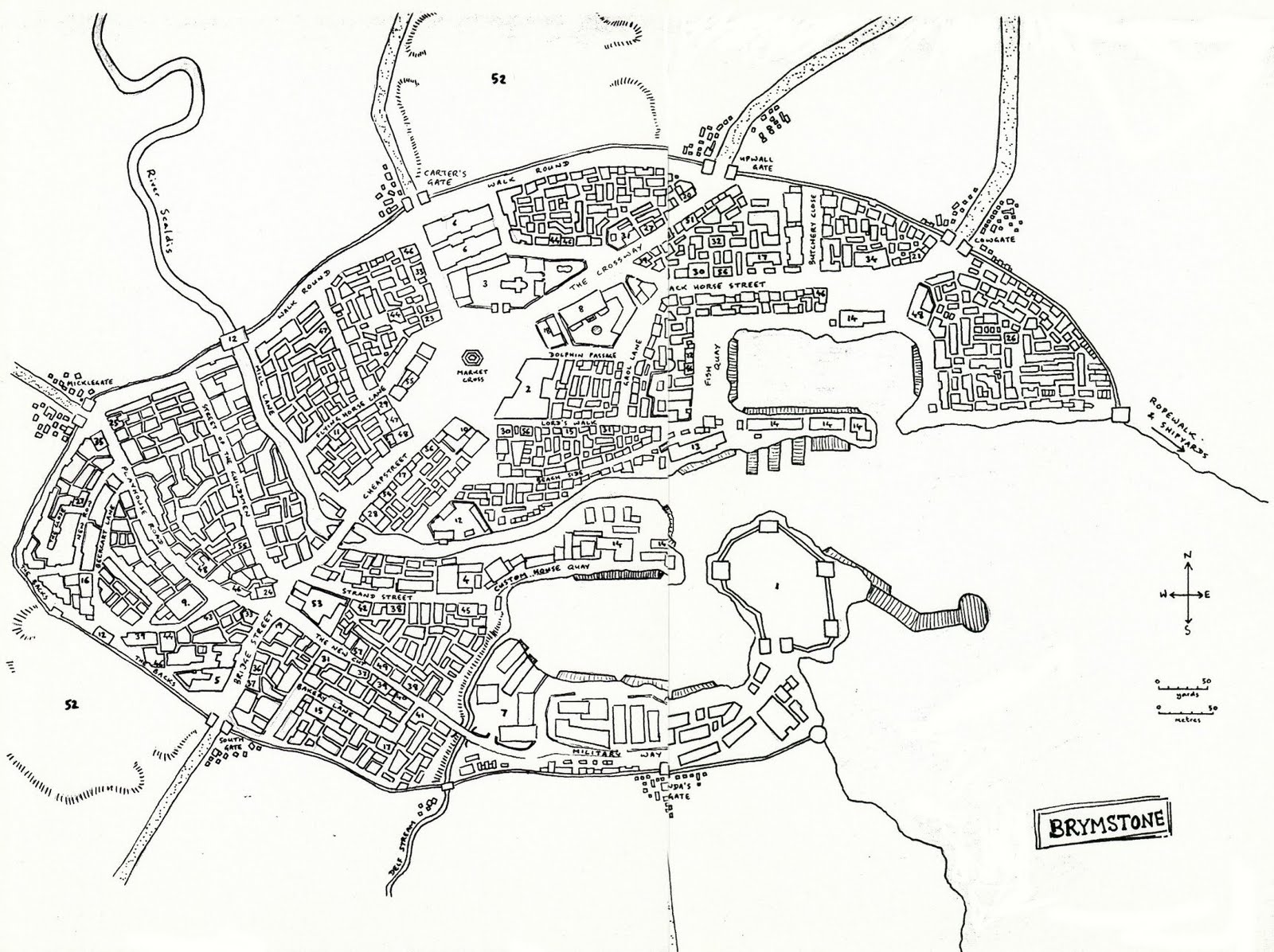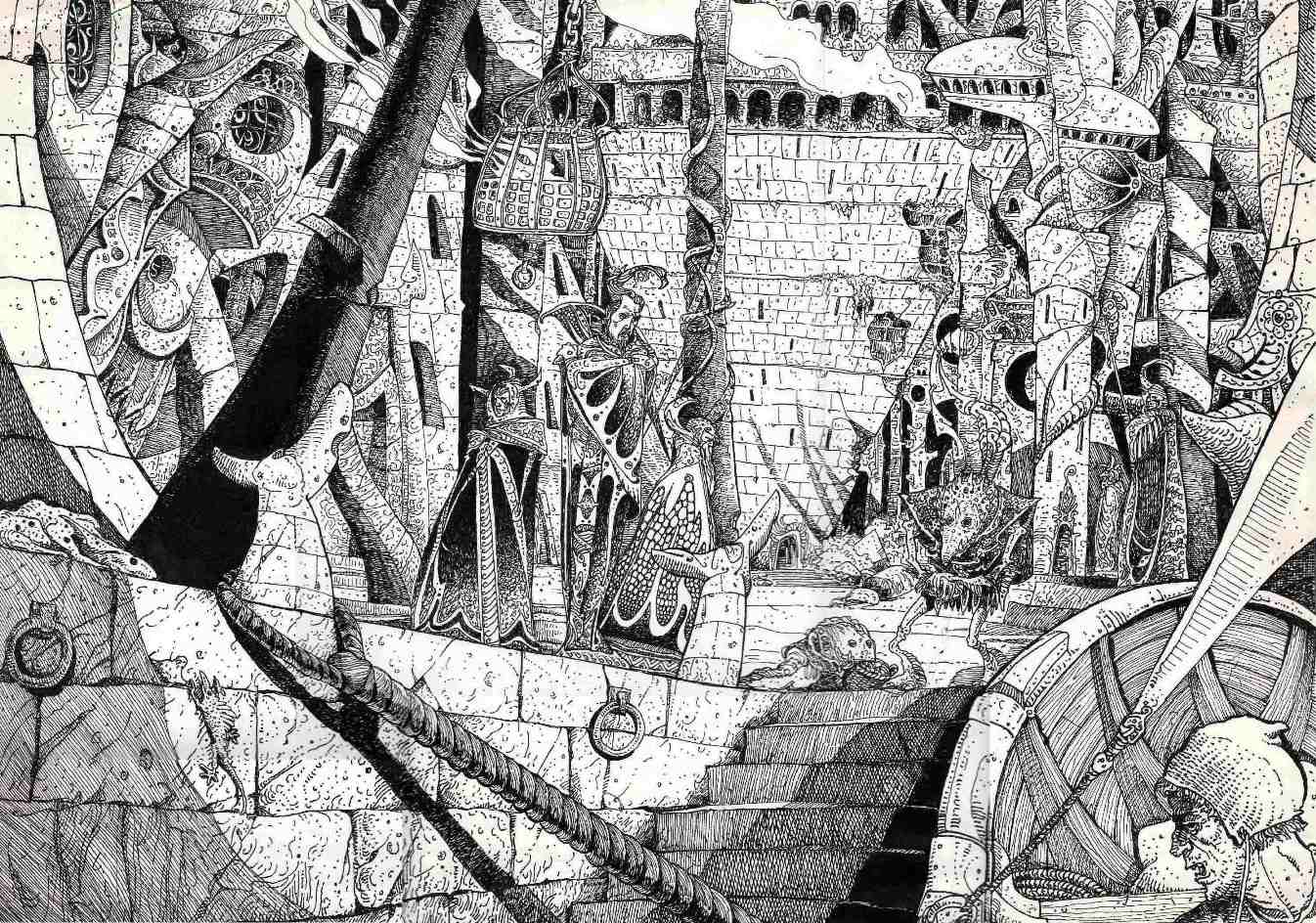Chapter 10,
Mungoda Gold is a scenario, based around going to Mungoda and looking for gold. I do like a nicely descriptive name. It's for a party of Rank 6-8, starting either in
Venice Ferromaine or somewhere nearby, half a continent (and the odd Rank) away from the previous scenarios set in
Britain Ellesland. I guess it's cosmopolitan enough that you don't need to worry about the language issues there.
Anyway, you are hired by a merchant to protect him as he sails to Mungoda (sorta South America squished into Africa, only Africa is also there to the east) and trade with the locals who've gotten some fancy gold stuff from somewhere or other. There's some nice intrigue in that the Knights in Ferromaine are very much involved with the local economy and would greatly prefer not to have large amounts of gold to be dumped on the market all of a sudden, whilst preparing to go all conquistador and get the lot for themselves. You might ask how much gold it'd take to make a difference, as Ferromaine is a trade centre and people are bringing in money all the time anyway. The answer would be that it's another one of those nice backstories Morris has written that nobody other than the GM will ever know about anyway, so that sort of thing doesn't actually matter. Oh well. The Knights have planted an Assassin on the ship posing as a crewman, but he's not likely to explain everything during a confrontation with the PCs unless the GM has been watching way too many British detective shows.
En route to Mungoda, you do run into a big ship full of Knights, only they are totally unrelated to all that, and are just on the way to the Crusades. So...that's nice? Barring the PCs getting bored with this adventure and going to join the Crusades instead, this is just filler.
Next, they run into another ship, this time full of pirates from Erewon, with a picture by Russ Nicholson.

Lucky for the Duke of Erewon a few books back that these guys are pirates, not adventurers, as they'd do a lot better at overthrowing his reign of evil than 4-6 1-2 Rank PCs. They use quite a bit of magic in attacking the merchant's ship, and also a catapult. There's rules for magic, some things are a bit vague, but I guess you could make up how long it takes an Air Elemental to find some nice treasure and take it back to the pirates. However, Morris has totally neglected the rules for the catapult. Oops. I do like how you don't have to kill them all, they don't want to risk themselves too much, they are in it for loot, not PC killing. OTOH, the pirates include 3 Warlocks rather higher Ranked (one Rank 13, two Rank 11) than the PCs (higher than the PCS are likely ever to get if playing fairly, one higher than Morris gives average stats for), and they are high enough rank to throw insta-kill spells around.
I thought I'd play through that encounter, see how difficult it was, taking average adventurers of the appropriate rank (with basic equipment, though, none of the weird magic stuff they'd likely have by then) and see how they go. So, one average Knight, Barbarian, Sorcerer and Mystic of Rank 6. All dead partway through round 2. Admittedly, the scenario is for 4-6 6-8 Rank PCS, and I've gone for 4 6th Ranked ones with no magic gear, and the Warlocks have used some magic points getting on board the merchant ship, but they still have enough MPs for 4 instakill spells (and change), any of them who doesn't get instakilled first is likely to kill a PC. First combat encounter, and the PCs should expect things to go badly for them. Even if nobody gets instakilled (or there are people on both sides left after the instakilling is done), a 13th or 11th Rank Warlock (and these ones are above average) is still about as good as a 12th or 10th Rank Knight. Published DW scenarios keep doing this.
Assuming you sit back and let the pirates nick some stuff and go away, the third encounter is a random high Rank GMPC wizard who invites the PCs to lunch and raises one dead person. If no PCs are dead, the GM needs the Assassin to kill the merchant so there's someone to raise. I guess random crewmembers don't count? Anyway, the wizard gives you some random magic stuff and sends you off again. So, unless a PC was dead and needed raising, more filler.
Then on to Mungoda. And it begins with:
All too often, players fondly imagine that their characters can get away with flaunting the rules of common sense. Just because DRAGON WARRIORS is a fantasy game, however, there is no reason to be unrealistic.
Yeah...I can see what he's going for there, but he could have put it a lot better than that. Anyway, the first way realism pops up is that being hot and tropical, you can't wear full armour, you have to strip down a bit, losing some Armour Factor and some magical bonuses if any. No mention of whether wearing less armour affects your Stealth or combat stats, I'm guessing it's intended not to. Fair enough...only it affects some Professions (those that wear heavy armour, such as Knights, Warlocks and to an extent Barbarians) much more than others. And I got the impression that Chainmail was a one piece thing so can't really be stripped down.
Realism also strikes via rules for four different tropical diseases. To which I am going to say "Argh, no!", everything about this is bad. Firstly, the chance of getting a disease depends on your Rank, with modifiers based on your Profession (for everyone who isn't a Sorcerer or Elementalist, I guess they are the default?) and whether or not you are wearing armour. The rules for Rank are notable in that they give the chances for Unranked to Rank 3, 4-6, 8-9 and 10+ which seems a little odd. Firstly, because the PCs are supposed to be Ranks 6-8 and so most of that doesn't apply (unless you roll to see if the NPCs die before you meet them or something) and secondly because there is no 7 in there.
Because you're a foreigner, you have little resistance to these diseases (unless you are a Barbarian that came from here, in which case you do, but there's no rules for this). You have to roll to see if you recover, and the modifiers for this include spells that have "totally cures all disease" in the description. One might think that such spells should have a very large modifier, possibly even big enough to make actually rolling superfluous, because of the "totally cure" part, but no. Because otherwise the Sorcerer would allow you to skip roleplaying one PC being stuck with a serious disease and missing the adventure while the healthy PCs get to play the game.
Anyway, supposing you aren't all killed by disease the merchant meets with his friendly local, who pretends to be a ethnic stereotype as a bargaining tool. There's a rival local who wants in on all this, and he's talking to people on another ship from Khitai who also want to get hold of all this gold. Their wizard has a long backstory players aren't likely to hear about, cause Morris likes that sort of thing.
Anyhoo, the friendly local is a bit less friendly cause he's worked out that while he doesn't think much of gold other people do and he should get a much better price, specifically that some high Ranked adventurer types go chase away a hostile tribe that has recently started making a nuisance of itself after wandering in from another scenario that Oliver Johnson wrote for Basic Dungeons and Dragons (published in White Dwarf 55, July 1984) that Morris took some ideas from. When they reach the other tribe, they find that they've camped in front of an
Egyptian Kaikuhuran pyramid full of treasure, the source of the locals' gold. The people from Khitai are also there trying to reach a bargain with them for the gold, but it's about to turn ugly, with a big combat full of high Ranked people and lots of mooks that, possibly 3 sided, and the DW rules almost certainly won't work very well at all.
Assuming you win and explore the pyramid (possibly with the assistance of people from Khitai if you play nice), it's full of gold stuff you can steal. If you want to go through the tunnel to the central chamber, a magic thingy weakens you, reducing you to 1 MP if you have MPs or taking off half your starting HP if you don't by the time you reach the door. The book says that a player could cast a durational spell, walking down the tunnel and dispel it, getting half the MP from casting it back. I say that as all casters get their magic back at specific times of the day, they wait till just before then before walking down the tunnel. As all casters get their magic back at different times, there may be arguments over when to do this, though. The magic thingy taking away MPs might have been intended to balance casters and fighters, previously Morris has said that casters initially have the advantage but run out of resources faster than fighters, and if you rest up between the big battle and the end boss it'd be a matter of how many instakill spells you cast until one goes through while the fighters stand in its way and totally fail to injure it enough to make a difference before it dies. Taking away almost all the casters' MPs and half of the fighters' HPs seem a reasonable way to simulate a grueling dungeon crawl, I guess. In any case, you then fight a (rather tough) guardian demon.
Wondering exactly how tough, I resurrected those 4 6th Rank adventures and threw them at the monster after being drained by the tunnel. They lasted 6 rounds, in that I somehow managed to roll critical misses for the Demon two turns in a row, each other round someone died. Fighters on half health due to magic thingy don't have more HP than the Demon takes away in one hit, but strong poison killed everyone anyway. And I now realise I've forgotten that people's armour factor is reduced due to being stripped down, but that didn't actually make any different. Again, the scenario is for 4-6 6-8 Rank PCS, and I've gone for 4 6th Ranked ones with no magic gear, and they might have joined forces with the people from Khitai, but even so. Now, if they'd used my trick of entering just after they've got their MPs back (or maybe used some potions or something to recover MPs) and could cast instakills, it's just a matter of what PCs it kills in one hit before it fails to resist one spell. Not a particularly fun encounter either way.
Assuming you win, you get lots of gold, the end. No magic stuff you'd actually want, just lots of stuff you can exchange for coins you don't need when you are this high Ranked.
This scenario is not great. I'd not say it was bad...well, except that the first fight is too hard, the second mightn't be too hard but would take forever to roll for to find out (or, you know, to actually play) and the third and last is an afterthought and also too hard. And the disease rules are just bad. And it also doesn't seem to have much in the way of Dragon Warrior's usual themes, there's nothing much going bump in the dark, no fay magic or untamed nature and while there is some murky politics, the characters won't know about it. I suspect deadlines might have been creeping up on Morris again and he didn't have time to put much in the way of substance in. I'd not be at all surprised if I've playtested it more than he did, having done two of the encounters once each.
I want to like it, I want to say something like "Sure, you'd have to redo all the parts with the rules, and then come up with a better story, but apart from that..." but no. I am again disappointed.



